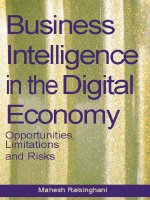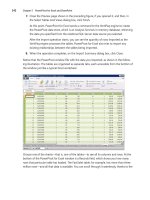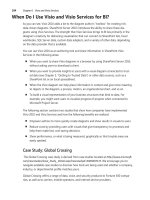higher nationals in computing unit 14 business intelligence assignment 1
Bạn đang xem bản rút gọn của tài liệu. Xem và tải ngay bản đầy đủ của tài liệu tại đây (2.35 MB, 34 trang )
<span class="text_page_counter">Trang 1</span><div class="page_container" data-page="1">
<b>Higher Nationals in Computing</b>
Unit 14: BUSINESS INTELLIGENCEASSIGNMENT 1
<b>Assessor name: Tran Le Ngoc Tran</b>
Learner’s name: LE BAO LONGID: GCS200247
Class: GCS1003ASubject code: 1641
</div><span class="text_page_counter">Trang 2</span><div class="page_container" data-page="2"><b>ASSIGNMENT 1 FRONT SHEET</b>
<b>QualificationBTEC Level 5 HND Diploma in ComputingUnit number and titleUnit 14: Business Intelligence</b>
<b>Re-submission DateDate Received 2nd submission</b>
<b>Student declaration</b>
I certify that the assignment submission is entirely my own work and I fully understand the consequences of plagiarism. I understand thamaking a false declaration is a form of malpractice.
<b>Student’s signatureGrading grid</b>
</div><span class="text_page_counter">Trang 3</span><div class="page_container" data-page="3"><b>Grade:Assessor Signature: Date:</b>
<b>Signature & Date:</b>
</div><span class="text_page_counter">Trang 4</span><div class="page_container" data-page="4"><b>ASSIGNMENT 1 BRIEF</b>
Student Name/ID Number
<b>Unit Number and Title14: Business Intelligence </b>
<b>Submission Format</b>
The submission is in the form of a 15-minutes Microsoft® PowerPoint® style presentation to be presented to your colleagues. The presentation can include links to performance data with additional speaker notes and a bibliography using the Harvard referencing system. The presentation slides for the findings should be submitted with speaker notes as one copy. You are required to makeeffective use of headings, bullet points and subsections, as appropriate. Your research should be referenced using the Harvard referencing system. The recommended word limit is 500 words, including speaker notes, although you will not be penalised for exceeding the total word limit.
</div><span class="text_page_counter">Trang 5</span><div class="page_container" data-page="5"><b>LO1 Discuss business processes and the mechanisms used to support business decision-making.LO2 Compare the tools and technologies associated with business intelligence functionalityAssignment Brief</b>
Your company is currently working in [Assumed Domain] for 2 years. For a new, young company, the competition in the market is very high. Therefore, the Board of Director has decided to apply Business Intelligence to improve the company business process by making better decisions.The Board of Directors assigns a small group including you in Research & Development Department to study business intelligence to apply for the company in the coming years.
You need to research about business processes and decision support processes in the company and identify the types of data (unstructured, semi-structured or structured) generated by these processes with examples. You also need to research about current software used in the business process or decision support process and evaluate these usages (benefits and drawbacks). Next you need to understand the types of support for decision-making at different levels (operational, tactical and strategic) within the company and study which business intelligence features can help on that types of support. Study the information systems or technologies (of BI) canbe used in this case, compare and contrast them to conclude which should be used.
Your group needs to present the research results to the board in a presentation of 15 minutes.
</div><span class="text_page_counter">Trang 6</span><div class="page_container" data-page="6"><b><small>PassMeritDistinction </small></b>
<b>LO1 Discuss business processes and the mechanisms used to support </b>
business decision-making.
<b>D1 Evaluate the benefits and </b>
drawbacks of using application software as a mechanism for business processing.
<b>P1 Examine, using examples, the </b>
terms ‘Business Process’ and ‘Supporting Processes’.
<b>D2 Compare and contrast a </b>
range of information systems and technologies that can be used to supportorganisations at operational, tactical and strategic levels.
<b>P2 Compare the types of support </b>
available for business making at varying levels within anorganisation.
<b>decision-M2 Justify, with specific examples, </b>
the key features of business intelligence functionality.
</div><span class="text_page_counter">Trang 7</span><div class="page_container" data-page="7"><b>3.Types of data generated by business processes:...5</b>
<b>4.Differences between Structured, Semi-structured and Unstructured data:95.Some of the software used in Business Processes:...10</b>
<b>III.Compare the tools and technologies associated with business intelligence functionality...11</b>
<b>A.Why utilize tools for business intelligence?...12</b>
<b>B.The resources and innovations :...12</b>
<b>1.Oracle BI (Business Intelligence):...12</b>
</div><span class="text_page_counter">Trang 8</span><div class="page_container" data-page="8"><b>ASSIGNMENT 1 ANSWERS</b>
Organizations try to optimize their operations in the today's quickly changing andintensely competitive business environment in order to increase effectiveness,productivity, and overall performance. The effective management of business processesis essential to accomplishing these objectives. The intricacy of these processes, thenecessary supporting systems, the creation of data, and the software used to assureappropriate operation are all covered in this article. Organizations try to improve theiroperations for effectiveness, efficiency, and success in a fast-paced, cutthroat businessclimate. This objective needs effective management of corporate operations. This articletries to investigate the complexity of business processes, as well as the systems thatsupport them, the data they produce, and the software used to make sure they workproperly.
</div><span class="text_page_counter">Trang 9</span><div class="page_container" data-page="9"><b>PROCESS' AND 'SUPPORTING PROCESSES' (P1):</b>
<b>A.B</b>
<b>USINESS</b><b> P</b>
<b>ROCESSES</b><b>:</b>
<b>1.Definition:</b>A business process is a group of interconnected actions that culminate in the supply ofa service or something to a customer. Another definition of a business process is a seriesof actions and activities that, when finished, will achieve an organizational objective.Business processes are organized, repeatable series of steps that transform inputs intodesired results to meet certain corporate objectives. They stand for the efficient flow oflabor, information, and materials inside an organization, enabling the creation,dissemination, and realization of value in products and services. A framework forplanning, coordinating, and completing work across multiple functional domains isprovided by business processes.
</div><span class="text_page_counter">Trang 10</span><div class="page_container" data-page="10">Business processes exist in diverse forms across industries. Some common examplesinclude:
<b>a) Procurement Process: The procurement process involves organizations’</b>
activities to acquire goods or services from external suppliers. It typicallyincludes identifying procurement needs, vendor selection, negotiation,purchase order creation, goods receipt, and invoice processing.
<b>b) Sales Process: The sales process encompasses the activities involved in selling</b>
products or services to customers. It typically includes lead generation,qualification, customer relationship management, order processing, fulfillment,and invoicing.
<b>c) Manufacturing Process: The manufacturing process encompasses all the</b>
activities related to producing goods. It includes product design, raw materialprocurement, production planning, quality control, assembly or manufacturing,packaging, and distribution.
<b>d) Human Resources Process: Human resources involve managing the</b>
organization's workforce. These processes may include recruitment andselection, onboarding, performance management, training and development,employee engagement, and offboarding.
<b>e) Customer Service Process: The customer service process involves activities</b>
aimed at providing customer support and assistance. It includes handlinginquiries, resolving customer issues, managing complaints, and ensuringcustomer satisfaction.
<b>f) Financial Process: Financial processes encompass managing an organization's</b>
financial resources. This may include budgeting, financial planning andanalysis, accounting, financial reporting, cash flow management, and financialdecision-making.
<b>B.S</b>
<b>UPPORTING</b><b> P</b>
<b>ROCESSES</b><b>:</b>
<b>1.Definition:</b>The "primary processes" are accompanied by "supporting processes," which often donot produce the organization's end output but rather indirectly increase value. Supportingprocesses include documentation, configuration management, verification, training, andaudit procedures. Supporting processes, usually referred to as management processes, are
</div><span class="text_page_counter">Trang 11</span><div class="page_container" data-page="11">successful decision-making. These processes offer the frameworks, tools, andinformation decision-makers at various organizational levels need to take decisions thatare in line with operational and strategic requirements. Supporting procedures areessential for attaining intended results, improving resource allocation, raisingproductivity, reducing risks, and cutting costs.
<b>a) Strategic Decision Making: High-level executives and top management</b>
determine the organization's long-term objectives. These decisions have asignificant impact on the overall success and competitiveness of theorganization. Market entry strategies, product diversification, mergers andacquisitions, and resource allocation are all examples of strategic decisions.Conducting market research, examining industry trends, assessing thecompetitive environment, and performing SWOT (Strengths, Weaknesses,Opportunities, Threats) analyses are all supporting processes in strategicdecision-making. These procedures assist decision-makers in gathering relevantinformation, evaluating internal capabilities, and making defensible decisionsconsistent with the organization's vision and mission.
</div><span class="text_page_counter">Trang 12</span><div class="page_container" data-page="12">organization’s operations and procedures. These decisions impact theefficiency, productivity, and quality of operations. Resource allocation,production planning, inventory control, and process improvement are allexamples of operational decisions. Collecting and analyzing real-time data,tracking performance, and undertaking continuous improvement projects allsupport operational decision-making processes. These procedures enabledecision-makers to identify bottlenecks, reorganize workflows, efficientlyallocate resources, and make operating decisions that maximize output whilereducing costs.
<b>c) Tactical Decision Making: Managers at the middle management level make</b>
tactical decisions by translating strategic goals into actionable plans and puttingthose plans into action to achieve operational goals. Pricing strategies,marketing initiatives, supplier selection, and workforce planning are allaffected by tactical decisions. Supporting processes in tactical decision-makinginclude data analysis, market segmentation, performance evaluation, andscenario planning. These procedures provide decision-makers with theknowledge and resources to weigh options, assess risks, allocate resources, andimplement tactical decisions consistent with the organization's strategicdirection.
<b>d) Risk Management: Risk management is a critical supporting process that</b>
involves identifying, assessing, and mitigating potential risks and uncertaintiesthat may impact an organization's goals. It entails methodically assessing risks,developing risk mitigation plans, and implementing controls to reduce theadverse effects of identified risks. Supporting processes in risk managementinclude risk identification methods, risk assessment procedures, riskmonitoring and reporting frameworks, and contingency planning. Theseprocedures enable decision-makers to safeguard organizational assets, dealwith risks proactively, and make wise decisions that mitigate the impact ofuncertainties.
<b>3.Types of data generated by business processes:</b>
Organizations can use the wealth of data generated by business processes for analysis,decision-making, and performance improvement. These are the various data categories:
</div><span class="text_page_counter">Trang 13</span><div class="page_container" data-page="13">Information that lacks a specified structure or format is referred to as unstructureddata. It is typically produced by humans and must be easily entered into databases orspreadsheets. Unstructured data, which includes details from emails, social networkpostings, customer reviews, papers, audio files, still photos, and video files, is frequentlytext-heavy. Due to its lack of structure, this data format is difficult to examine usingconventional data processing methods.
Unstructured data can offer insightful information about customer views, markettrends, and emerging issues. To extract usable information from unstructured data,sophisticated techniques like natural language processing (NLP), text mining, sentimentanalysis, and picture or audio recognition are needed.
Data must be changed into a more structured format suited for analysis before beinganalyzed when it is semi-structured. Examples of these approaches include dataextraction, data transformation, and data parsing.
Customer reviews, social media postings, customer service chat logs, emailcommunications, survey answers, research findings, and multimedia material are a fewexamples of unstructured data used in business operations.
</div><span class="text_page_counter">Trang 14</span><div class="page_container" data-page="14">Between unstructured and structured data is semi-structured data. It complies withloose schemas or preset formats yet incorporates metadata or has some organizationalstructure. Semi-structured data still allows for some organization and categorizationwhile maintaining its flexibility.
Spreadsheets, XML ( eXtensible Markup Language), JSON (JavaScript ObjectNotation), CSV (Comma-Separated Values), and other formats are frequently used torepresent semi-structured data. It could have properties or tags with labels, whichprovide structure and make organizing and analysis easier.
Log files, web server logs, sensor data, XML or JSON files, spreadsheets with labeledcolumns, and data obtained by web scraping are examples of semi-structured data.
</div><span class="text_page_counter">Trang 15</span><div class="page_container" data-page="15">Well-organized and simple to examine is structured data. It is appropriate forrelational databases or data warehouses to store this information since it adheres to a setstructure or schema. Structured data can be numerical, category, or alphanumeric and isoften shown as tables with rows and columns.
Businesses may easily develop reports, spot trends in structured data, and makechoices based on accurate and trustworthy information. Using common databasemanagement systems and tools, structured data is easy to query and manipulate.
Customer transaction records, sales numbers, inventory data, financial statements,personnel records, website analytics data, and supply chain data are a few examples ofstructured data.
</div><span class="text_page_counter">Trang 16</span><div class="page_container" data-page="16"><b>PropertiesStructured dataSemi-structureddata</b>
<b>Unstructureddata</b>
</div><span class="text_page_counter">Trang 17</span><div class="page_container" data-page="17">Relationaldatabase table
XML/RDF(Resource DescriptionFramework).
character and binarydata
Maturedtransaction and
Transaction isadapted from DBMS
not matured
No transactionmanagement and no
Versioning overtuples, row,
Versioning overtuples or graph is
Versioned as a whole
<b>Flexibility</b> It isschemadependent and
less flexible
It is more flexiblethan structured databut less flexible thanunstructured data
It is more flexibleand there is absence
of schema
<b>Scalability</b> It is verydifficult to scale
DB schema
It’s scaling issimpler thanstructured data
It is more scalable.
<b>Robustness</b> Very robust New technology, notvery spread
Structured queryallow complex
Queries overanonymous nodes
are possible
Only textual queriesare possible
<b>5.Some of the software used in Business Processes:</b>
Organizations use various software solutions to improve and streamline businessoperations. The following are examples of popular business software:
<b>5.1.Data Analytics and Business Intelligence (BI) Software: Organizations can use</b>
these software solutions to analyze and interpret massive amounts of data todiscover insights that can be used. They include advanced analytics, reportingsystems, and data visualization tools. Tableau, Microsoft Power BI, and QlikVieware three well-known data analytics and business intelligence (BI) programs.
<b>5.2.Project Management Software: Project management software makes planning,</b>
scheduling, and executing projects easier. It helps with task management,
</div>








